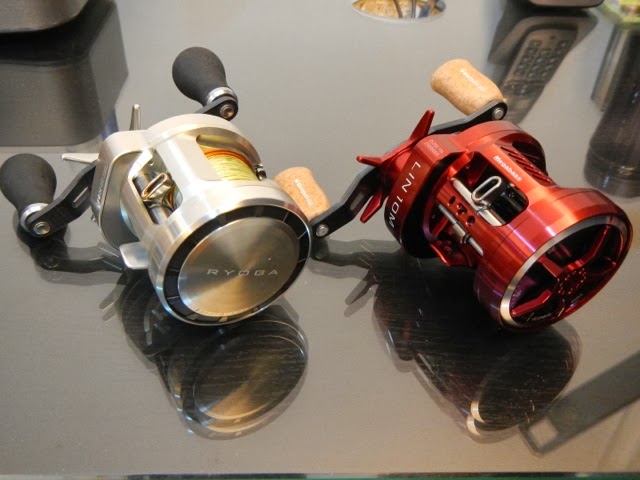Went crazy and bought it yesterday...
Serial numbered #250.
The LIN Series baitcasting round profile reels from Megabass are developed based on Daiwa's Ryoga 1016 and as such, they share similar shape and weight.
 |
| Left: Daiwa Ryoga 1016H Rght: Megabass LIN10 MARS |
Even so, Megabass's Yuki Ito took things to a whole new level with his MARS...
Holding it in my palm, it somehow feels slightly smaller compared to the Ryoga.
Might be MARS's improved ergonomics.
Might be my mind playing tricks?
Original spool from the MARS is very similar to the stock Ryoga's RCS1016 spool.
They even weigh the same at 14.5 grams based on readings from my digital scale.
But when compared to my RCS SV1000, that's where the difference shows.
 |
| Left: Lin 10 Mars original spool Right: RCS SV1000 spool |
MAR's inductor is way thicker (naturally heavier as well) than the SV1000's.
This translates to a slower start up inertia.
In addition, the SV1000 weighs a full gram lighter.
The difference in weight gets much wider once both are fully spooled with braided line since the SV1000 is a performance shallow spool which can only hold almost half of MARS's line capacity.
When it comes to baitcasting spools, every gram makes a hell lot of difference in it's accelerating rotation speed.
In a trained and experienced casting hand, a faster start up speed will produce significantly farther casting distance with today's super lines.
No prize for guessing which spool I'll use for MARS.
I decided to retain it's cork paddle knobs for a while.
Will swap it out with my RCS Eva knobs eventually.
The RCS provides better grip when wet but it's heavier weight is a trade-off.
Enough of the boring technical stuff...
Let's see how the real thing looks like:
 |
| Megabass LIN10 MARS |
 |
| Designed by the man, Yuki Ito himself |
 |
| 90mm Carbon crank comes stock along with twin bearings cork paddle knobs. One thing to note is that it's crank nut is a size smaller than Ryoga's. |
 |
| Every single piece of LIN10 MARS has it's own unique serial number. Mine is serial numbered #250. |
 |
| Sideplate is a major head turner! |
 |
| Top view |
 |
| Bottom view |
Even the reel's bottom is not spared.
When mounted on my G.Loomis NRX, the MARS's stock knobs compliments my rod's cork handle very well indeed:
 |
| G.Loomis NRX 804C JWR Megabass LIN10 MARS |


While snapping these photos last night, I finally realised why Megabass's reels cost so much apart from it's racy cosmetic appeal.
Holding the reel just by itself, I can feel that it weighs slightly lighter compared to my Ryoga 1016H.
Some improvements were made to the guts as the MARS's cranking feels 'tight'!
Even a brand new Ryoga 1016H will have at least a little bit of freeplay.
Nothing else.
However, when mounted on a rod and palmed, something else hits me.
Hard!
The feeling is totally different from Ryoga!
Even though both reels are based on the same platform with almost the same outer dimension.
It's hard to explain and I swear that my mind is not playing tricks on me.
Yuki Ito had somehow worked his dark magic on his LIN series.
It just..... feels...... right!
A friend who owns several Megabass reels had told me once before that there is something about the LINs that makes them feel very different from it's Daiwa counterpart.
'Higher rigidity with increased finesse factor' was what he was trying to convince me.
I dismissed his statement as total bullshit.
I was wrong...
But who can blame me when there is absolutely no logic that 2 objects very similar in dimensions can feel so differently in the same pair of hands?


Now, whoever is reading this post (if any) might argue that my above opinions are biased towards the newly acquired MARS.
People who know me personally witnessed that I love my Ryoga 1016H very much and have been using it faithfully for years.Only anglers who own both Ryoga 1016 and LIN can attest to my statements.
Still doubting?
Go buy one and fish it.
Be enlightened.
Just as I did last evening...

The best post!!!
ReplyDelete